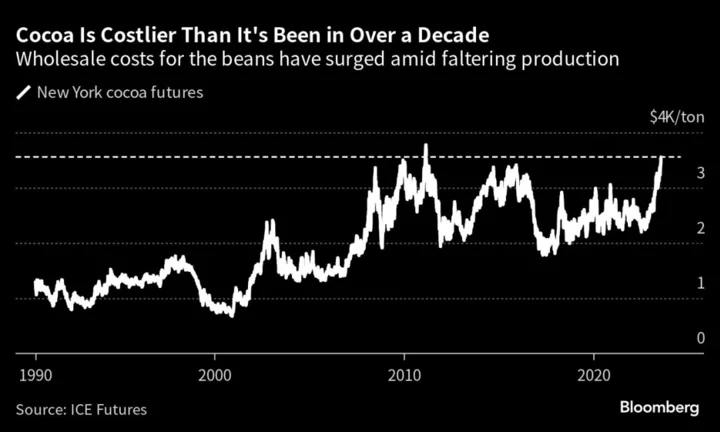Bad news has emerged this week for chocolate lovers: it’s going to get more expensive to satisfy your cravings.
The cost of wholesale cocoa beans soared to the highest level in more than a decade, and manufacturers are betting prices of the key chocolate ingredient will stay elevated through 2024. That’s mainly because production in West Africa, a region that accounts for two-thirds of the world’s bean harvest, is faltering.
Heavy rains and a rot-causing disease have ravaged crops there, sparking concerns about supply. Bean processing has also slumped around the world — which is crucial for turning products into chocolate — indicating that factories are struggling to access adequate volumes, according to Fuad Mohammed Abubakar, the head of Ghana Cocoa Marketing Company UK.
That’s prompted executives from top manufacturers Lindt & Spruengli AG and Hershey Co. to warn this week that further price hikes can’t be ruled out, even after consumers have already had to swallow higher costs for their products.
“We clearly are in a very tight situation,” said Paul Joules, a cocoa analyst at Rabobank in London. “We could see chocolate companies adopt smaller chocolate bars and potentially higher prices.”
The world’s biggest cocoa producer Ivory Coast is expected to see its upcoming harvest shrink by nearly a fifth from last year, and has suspended sales that bind farmers to delivering goods at specified times in the future. In Ghana, the second-biggest cocoa producer, output is set to fall below historical averages.
That’s likely to put the world on track for a third consecutive supply deficit this year and possibly even the following, according to Joules. An El Niño weather pattern threatens to hurt output further, just as farmers contend with the swollen-shoot virus, a devastating disease that can kill trees within years, and black pod disease, which causes beans to rot.
While the pandemic led to a slowdown in global chocolate demand and caused cocoa stockpiles to surge, recovering consumption and two years of supply shortages have significantly reduced those inventories. Lindt is building up its cocoa bean stocks as a buffer against higher prices and shortages, it said this week. Both Lindt and another Swiss chocolate maker, Barry Callebaut AG, have seen sales volumes suffer as higher prices force consumers to hold back.
For some companies, the effect of soaring wholesale costs might only just be filtering through, due to previous hedging activities that so far shielded them from big price hikes.
“For most players, the impact of the very steep cocoa future prices increases will only kick in from the second half of 2023,” Lindt’s Chief Financial Officer Martin Hug told analysts in an earnings call on Tuesday. Those feeling additional cost pressure “will therefore most likely feel a need to adjust pricing.”
Author: Mumbi Gitau, Ekow Dontoh and Baudelaire Mieu

